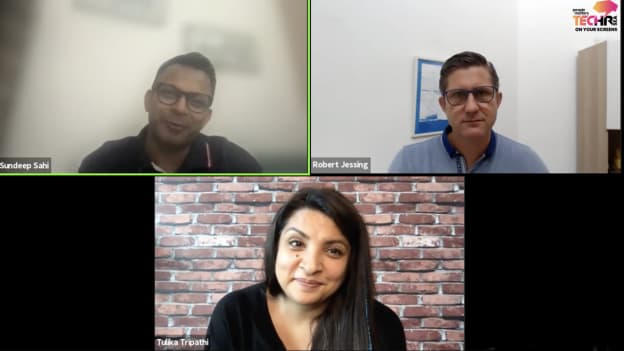Efficiently managing a distributed workforce

The blurring of boundaries is leading many companies to turn to a remote workforce. Organizations also want to tap into a future-forward talent pool, as they navigate the modern-day challenges related to fast growth. While remote working can exist in various models, often, it boils down to managing a geographically & culturally diverse talent pool. As a result, HR and people management must happen in a renewed light, with new perspectives and new mindsets.
In an interesting session at People Matters TechHR SEA 2021, Tulika Tripathi, Founder & CEO, Snaphunt and Sundeep Sahi, Co-Founder, Skuad shed light on how organizations can efficiently manage a distributed workforce.
The critical need to manage a remote workforce
To build, manage, develop, and grow a remote workforce, people practitioners must look across the entire employee life cycle across the following elements:
- Right platforms to enable the HR processes, right from hiring the remote squad to exiting employees.
- Robust processes to engage employees across all employee touchpoints
- Bring the softer elements to life through the right leadership and culture
Organizations must deep dive into the above foundation blocks, while they conceptualize and curate the remote strategy. It is equally important to understand that remote models may vary greatly- it can mean working in the same city yet different buildings, or people working from home, or teams working across countries.
The starting point is to define what remote means for the organization and for its people, and then drill it down to region-wise processes such as payroll, policy, contracts, compliances etc. Building a strong core of systems and structures will further help manage the softer emotional and security i.e. self-actualization needs of people in a remote environment.
Upholding the softer elements: the key to remote success
Building an effective remote team is basically about bringing people together. So, the team-building tenets of Forming-Storming-Norming-Performing not only apply here but are critical to success, especially because remote workers may have not have seen or worked closely with each other. Hence, when bringing in diverse talent, whether in the same country or across geographies, the values and cultural alignment are important.
The talent strategy must be based on the real challenges of remote working across the employee life cycle i.e. from employer branding to talent search, to talent evaluation, to assessing the organization’s remote-friendliness. These elements must be built into the relevant policies and structures. Much of this stems from the softer aspects such as, “What is the culture?”, “Are employees communicated to?”, “Are employees participating?”, and so on.
Building a remote-first organization begins with training leaders to build connections with the team through 1-0-1s, creating a structure for seamless communication, and basically, thinking from the first principle of bringing people together and aligning them with the culture and values. HR plays an active role to ensure people feel the “value” despite different employment models.
For example, a freelancer role varies significantly from a full-time remote role. While a freelancer usually seeks complete flexibility, project-based work, and short-term deliveries; a remote full-time professional is expected to stick, strive, and help strategize the company’s growth. The CHRO must curate the talent strategy to attract the right remote talent, and constantly revisit and revise it as the talent needs change. This can be done by looking at:
- Skill i.e. the lowest predictor of performance.
- Competency i.e. indicative that the candidate can do the job and adapt
- Motivation i.e. the biggest predictor that evaluates whether peoples’ career goals are aligned with what the company offers.
These individual-level talent elements must complement the collective behaviors, especially when solution-ing for diverse talent across geographies. Different regions have different ways of expressing needs, desires, and emotions; hence people processes must be based on respect for diverse cultures and opinions. A more humane approach helps give employees comfort, encourages them to approach leaders and be vocal. This is possible when hiring for a culture fit.
Hiring for culture fit
Culture is difficult to align. Yet, embracing the below elements in the talent processes can serve as a starting point:
- Instating the organizational mission and goals: People want that one important motivator to come to work, hence HR must make clearly define that element and integrate it into every employee process.
- Embodying the organizational values: People relate to values, hence the job of the modern-day remote leader is to embody and reiterate these at every session, whether platforms, processes or people. HR must coach their leaders accordingly.
- Ensuring channels of communication across directions: To make this come alive, HR must institutionalize the goals and values through all possible communication channels, for example providing people feedback quickly and early on.
Above all, a true-blue remote team thrives on transparency and simplicity, to compensate for the lack of the 3D element.
The role of technology to support remote teams
To front-end the management of a remote workforce at scale, HR must leverage data for decision making. Data-driven hiring greatly helps identify the skills, competencies, and motivations that are aligned with the role. Co-employment is another opportunity wherein organizations can hire and manage employees through a third-party subject matter expert. It helps manage the local nuances of cross-location hiring, such as understanding the structures and local behaviors, and thereby creating infrastructure for local payroll and admin, etc.
Whatever the remote model, HR must invest in building the right remote tools for communication, so as to enable people to connect formally and informally on a real-time basis.
In conclusion
While leaders and technologies will do their bit in building a thriving remote team, the onus for remote success lies significantly on the employee. Employees must upskill themselves to cultivate competencies like self-starter, communication, speaking up, proactiveness, etc. This must go hand-in-hand with organizations’ proactive measures to acknowledge and appreciate in real-time. Thus, employees, leaders, and HR must hold hands closely to build a remote-centric growth charter and move ahead with purpose.
















